Brief introduction of Structural steel forged parts
Structural steel forged partsis a workpiece or blank obtained by forging and deforming a metal blank.,be of high quality,low in price。
1、Brief introduction of Structural steel forged parts
Structural steel forged partsplastic deformation is made to obtain forgings with certain shapes and mechanical properties.,is a popular Structural steel forged parts,usually used in energy, construction machinery, war industry, pressure vessel, energy and other fields,is based on Jianing forging is a Structural steel forged parts newly developed by Jianing forging。

Structural steel forged parts
2、Structural steel forged parts picture
The Structural steel forged parts is designed by Jianing forging with advanced technology, and the product has high performance advantages. In order to facilitate our customers to find a satisfactory forging more quickly, the following high-definition pictures are provided for reference.。

Structural steel forged parts
Note: All the pictures in this article were taken by Jianing manufacturer.。
3、Introduction of advantages of Structural steel forged parts
The advantages of Structural steel forged parts are as follows:
- High degree of automation
- high tenacity
- Replace other processing methods
- high-intensity
- Good fatigue resistance.
Modern forging equipment has a high degree of automation, which can realize continuous and efficient production and greatly improve production efficiency.
The fiber structure of the Structural steel forged parts is reasonably distributed, which improves the toughness of the material and enables the Structural steel forged parts to bear greater impact force and alternating stress.
In some cases, Structural steel forged parts can replace parts produced by other processing methods (such as casting, welding, etc.), thus simplifying the production process and improving production efficiency.
Through forging, the internal structure of the metal is denser and the grain is refined, thus improving the strength of the material. Hot forging promotes crystallization and grain refinement, which enables materials to achieve the greatest possible strength and consistency, and reduces the variation between parts.
The particle flow inside the Structural steel forged parts flows precisely along the contour of the part, and these continuous streamline lines are beneficial to reduce the incidence of fatigue or common faults.

Structural steel forged parts
4、Structural steel forged parts explanation video
On-site aerial photography of Structural steel forged parts。
Structural steel forged parts
As you can see from the live video.,Jianing the product looks beautiful.。
5、Structural steel forged parts performance advantage
Structural steel forged partss have the following advantages.
- Good chemical uniformity
- Improve material utilization rate
- Perfect quality assurance system
- Eliminate internal defects
- High dimensional accuracy
Forging can disperse the segregation of alloy or nonmetal and make the Structural steel forged parts have excellent chemical uniformity.
In the process of Structural steel forged parts production, through accurate blanking and forging process, the utilization rate of raw materials can be maximized and waste can be reduced.
In the process of Structural steel forged parts production, a perfect quality assurance system is established, and the raw materials, production process and finished product inspection are strictly controlled to ensure the reliable quality of the Structural steel forged parts.
During the forging process, the porosity, shrinkage cavity, cracks and other defects in the metal are closed under the action of high temperature and pressure, thus improving the structural integrity of the Structural steel forged parts.
In the forging process of Structural steel forged parts, high dimensional accuracy and shape accuracy can be obtained through the precise forming of dies.

Structural steel forged parts
6、Structural steel forged parts advantage
The advantages of Structural steel forged parts are as follows:
- Meet the requirements of complex working conditions
- Reduce the amount of subsequent processing
- high tenacity
- High degree of automation
- Reduce the amount of subsequent processing
The Structural steel forged parts has excellent mechanical properties and structural integrity, which can meet the use requirements under complex working conditions and ensure the long-term stable operation of the equipment.
The forming precision of the Structural steel forged parts is high, and the subsequent processing amount is relatively small, thus saving the processing cost and time.
The fiber structure of the Structural steel forged parts is reasonably distributed, which improves the toughness of the material and enables the Structural steel forged parts to bear greater impact force and alternating stress.
Modern forging equipment has a high degree of automation, which can realize continuous and efficient production and greatly improve production efficiency.
The forming precision of the Structural steel forged parts is high, and the subsequent processing amount is relatively small, thus saving the processing cost and time.

Structural steel forged parts
Structural steel forged partsrefers to the workpiece or blank obtained by forging metal blank.,the product looks atmospheric.。
Related recommendation
-

What is a 16Mn alloy free forging? How much is the price of the forging?
2025-5-26 -

主轴锻件
2024-12-10 -

Introduction to Austenitic stainless steel flange, introduction to flange function advantages and characteristics
2025-5-26 -

大型环形锻件
2024-12-10 -

What is a Plate welded steel pipe flange cover? Introduction to the advantages, characteristics, and principles of the flange
2025-5-26 -

What is a 310s flat welding flange plate? Introduction to the advantages and characteristics of the flange
2025-5-26 -

Introduction to Carbon steel pressure vessel flange ring and flange advantages and features
2025-5-26 -

Introduction to RF welded flange cover and flange advantages and features
2025-5-26 -

输油管锻件
2024-12-10 -

2cr13 ring forging component detailed introduction
2025-7-14




